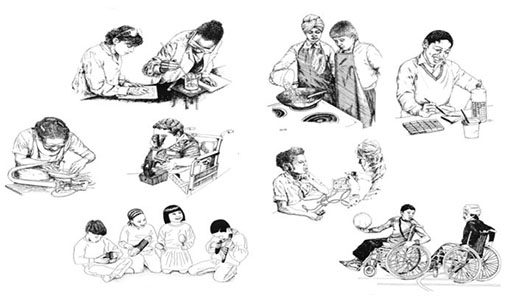5.4 Resources for all
The teacher must prepare their lessons that stimulate all the pupils’ interests. One aspect of the preparation is to identify resources that will assist or encourage the pupils to learn.
a. Where to get resources
It is not always easy to find the resources you need. You will often have to be a resourceful, creative and inventive teacher.
Activity 25: Appropriate resources
During this activity, teachers will identify appropriate resources.
- Download and read the following key resources from the TESSA website [Tip: hold Ctrl and click a link to open it in a new tab. (Hide tip)] :
- As you read these documents, highlight the ideas listed in them that you can easily reuse in your class. If these ideas trigger new ones, write them down in the margin.
![]() If you are working with groups of teachers, share, discuss and develop these ideas. During your work with TESSA resources, make notes of how useful these resources/ideas that you have put into practice were and how you could improve them.
If you are working with groups of teachers, share, discuss and develop these ideas. During your work with TESSA resources, make notes of how useful these resources/ideas that you have put into practice were and how you could improve them.
TESSA resources offer many examples of teacher ingenuity in terms of finding resources: a list of objects is drawn for the making of musical instruments in Resource 2, Section 4, Module 3 of Social Sciences and the Arts (Primary) or, in the same module, old tools traditionally used in agriculture brought by a member of the community (Case study 2 of Section 2). The teacher cannot do without this invaluable support. It may even be the case that some community members are happy to share resources for the classroom and for the school.
b. Choosing or developing learning resources
When selecting and preparing learning resources, whether they are especially tailored or collected from the classroom, school or community, teachers should analyse them from different perspectives.
Selected or made-up resources must meet everyone’s needs. If in a class, there are one or more children with disabilities, do these resources enable all of the children to learn? Are they multi-sensory so that everyone may benefit from them? If these children are blind, will they be able to touch, smell and listen? If they are deaf, will they be able to visualise the information, smell or feel? The stories in Case study 8 illustrate how teachers think carefully about resources that will be used to enable all children to be able to carry out the learning activity.
The selected resources convey a positive image of people belonging to minority groups
Activity 26: Selecting resources that convey a positive image of people in vulnerable minority groups
This activity helps to identify or create resources that enable a) pupils with disabilities to identify with the selected materials and b) pupils without disabilities to appreciate that everyone can contribute to one’s learning.

- Look at the illustrations of school subjects in the pictures above: how do they promote inclusion among pupils?
- Now download the following three TESSA resources from the TESSA website. Read them carefully and reflect on them. How could they be adapted in order to give a positive image of people with disabilities?
- Mr Simon Ramphele organises a session to read newspaper articles on famous people: Case study 2 of Section 4 of Module 2 of Literacy (Primary)
- Resource 3 of Section 4 of Module 2 of Literacy (Primary) on using praise poems
- Resource 4 of Section 4 of Module 2 of Literacy (Primary) on preparing to write a biography.
As you read and discuss ideas with colleagues, add to your own collection of ideas.
While allowing children with disabilities to have a positive image of themselves, the chosen resources convey the message to all children that everyone can access the same opportunities: boys learn home economics, girls do science experiments, children in wheelchairs play basketball, etc. To further enhance the image of minority groups, Mr Ramphelecould include a few articles about Paralympic athletes or fashion models wearing a prosthetic leg. In the discussion and preparation for writing the biography, why not choose a character representing a vulnerable group of the population?
c. A resource centre for the school or for several schools?
The same resources will be useful to many teachers in the same school. It would therefore be appropriate to catalogue these resources and share them within the school.
Case study 9: A group of student teachers create a resource centre

During her teaching practice, Aisha had to teach a sequence of lessons on weather forecasting. She remembered the work she had done using TESSA resources in her NTI* Distance Education modules. She researched Section 3 of Module 1 on Social Studies and the Arts (Primary), and decided to build a weather station for her class using the instructions from the Resource 3: ‘Measuring the wind direction and speed’. Her sequence of lessons was a great success for both the pupils and teachers of the school.
Back at the NTI Regional Centre in Kaduna, during a feedback session on the teaching practice, Aisha shared her success and experience. Inspired by her success, the other student teachers expressed the wish that she shares her resources with all of them, and also with teachers in the training schools.
The student teachers received permission from the Head of the Regional Centre for the creation of a mini resource centre located in a small room. They put in all their resources and shared them with the teachers of the local school.
* NTI: National Teachers' Institute, Kaduna, Nigeria
Following this example, one or two teachers could be responsible for collecting and managing learning resources in a school. This would allow teachers to share and integrate all their good ideas for the benefit of all children.
5.3 A directory of activities



